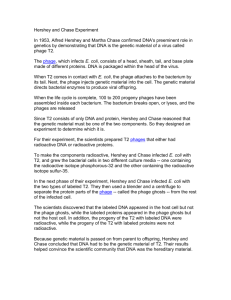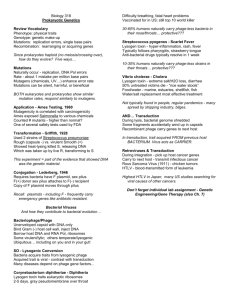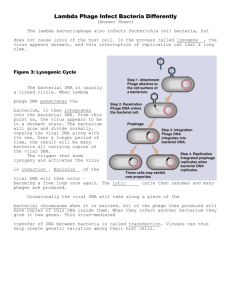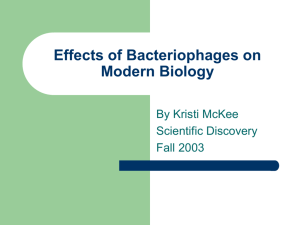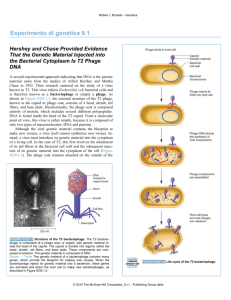Hershey–Chase Experiment - Section of Plant Biology
advertisement
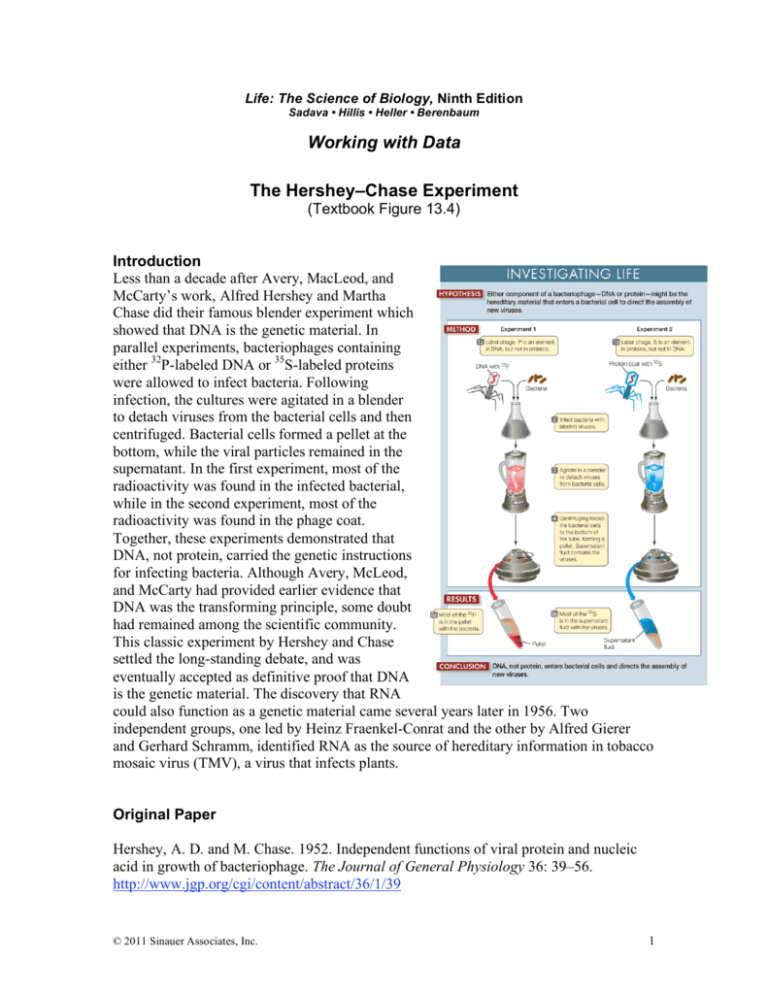
Life: The Science of Biology, Ninth Edition Sadava • Hillis • Heller • Berenbaum Working with Data The Hershey–Chase Experiment (Textbook Figure 13.4) Introduction Less than a decade after Avery, MacLeod, and McCarty’s work, Alfred Hershey and Martha Chase did their famous blender experiment which showed that DNA is the genetic material. In parallel experiments, bacteriophages containing either 32P-labeled DNA or 35S-labeled proteins were allowed to infect bacteria. Following infection, the cultures were agitated in a blender to detach viruses from the bacterial cells and then centrifuged. Bacterial cells formed a pellet at the bottom, while the viral particles remained in the supernatant. In the first experiment, most of the radioactivity was found in the infected bacterial, while in the second experiment, most of the radioactivity was found in the phage coat. Together, these experiments demonstrated that DNA, not protein, carried the genetic instructions for infecting bacteria. Although Avery, McLeod, and McCarty had provided earlier evidence that DNA was the transforming principle, some doubt had remained among the scientific community. This classic experiment by Hershey and Chase settled the long-standing debate, and was eventually accepted as definitive proof that DNA is the genetic material. The discovery that RNA could also function as a genetic material came several years later in 1956. Two independent groups, one led by Heinz Fraenkel-Conrat and the other by Alfred Gierer and Gerhard Schramm, identified RNA as the source of hereditary information in tobacco mosaic virus (TMV), a virus that infects plants. Original Paper Hershey, A. D. and M. Chase. 1952. Independent functions of viral protein and nucleic acid in growth of bacteriophage. The Journal of General Physiology 36: 39–56. http://www.jgp.org/cgi/content/abstract/36/1/39 © 2011 Sinauer Associates, Inc. 1 Links (For additional links on this topic, refer to the Chapter 13 Experiment Links.) Memorial University of Newfoundland: Hershey and Chase 1952 http://www.mun.ca/biology/scarr/4241_mkm_hersheychase.htm PubMed: Tobacco mosaic virus RNA as genetic determinant: genesis of a discovery http://www.ncbi.nlm.nih.gov/entrez/query.fcgi?cmd=Retrieve&db=PubMed&list_uids=1 1256209&dopt=Abstract Descriptions of Plant Viruses Web: tobacco mosaic virus http://www.dpvweb.net/dpv/showdpv.php?dpvno=370 Analyze the Data Hershey and Chase prepared two types of phage T2 particles: one with their protein coat labeled with radioactive sulfur (35S; in the original paper written S35), and one with their DNA labeled with radioactive phosphorus (32P; in the original paper written P32). Two previous observations were especially important: First, just after an infection cycle began, electron micrographs showed phage particles still attached to the outside of the cell wall of the host bacteria, only the particles looked like empty “ghosts.” Second, these ghosts could be prepared in the test tube by incubating T2 phage in water (plasmolysis). To determine what was released from the plasmolyzed phage, the scientists incubated both types of labeled phage in water. They tested for the presence of labeled DNA or protein, whether or not the molecules were acid-soluble (had been hydrolyzed to monomers— nucleotides or amino acids), whether or not they could attach to bacteria, and whether or not they reacted to antibodies for intact T2 phage. The results are shown in Table 1. © 2011 Sinauer Associates, Inc. 2 Question 1 Compare the DNase treatment of intact phage and plasmolyzed phage. What can you conclude about the presence of DNA in intact phage and ghosts? Question 2 What happened to the DNA after the phage was plasmolyzed? Why did this not happen to the protein? Question 3 Explain the antibody data in terms of what remains of phage particles when they become ghosts. The fragile attachment of phage to the outside of host bacteria led the scientists to allow attachment and then agitate the bacteria-phage to try to remove the latter. Then, the distributions of radioactive labels were determined. Also, the infection of the host bacteria was tested. Data are shown in Figure 1. Figure 1 Question 4 What are the differences between the distribution of the labeled protein and DNA? What conclusion can you draw about the infection process? Question 5 Relate the data and conclusions seen in Figure 1 to those in Table 1. Question 6 Why was the infection rate of bacteria an important measurement? © 2011 Sinauer Associates, Inc. 3 Question 7 Can you explain why over 30% of the 32P label was in the extracellular fraction? © 2011 Sinauer Associates, Inc. 4
